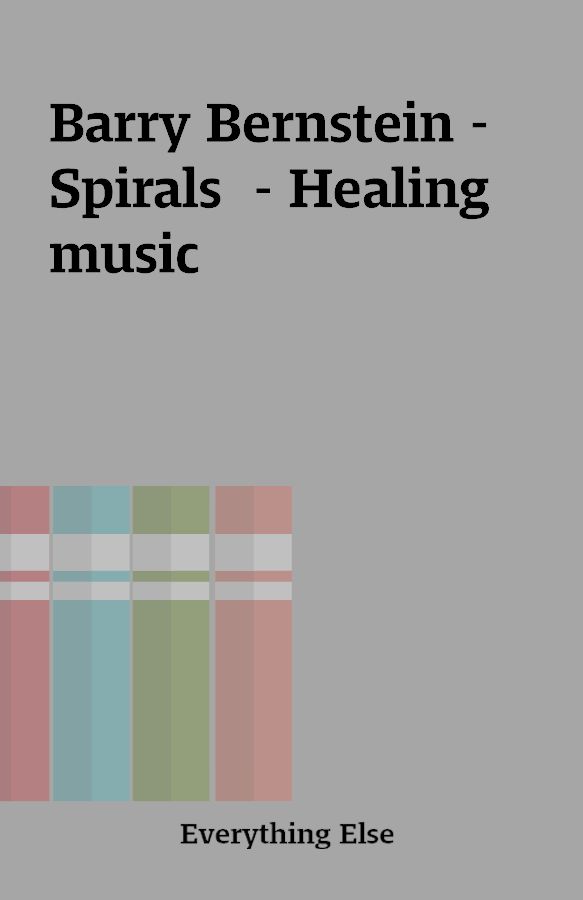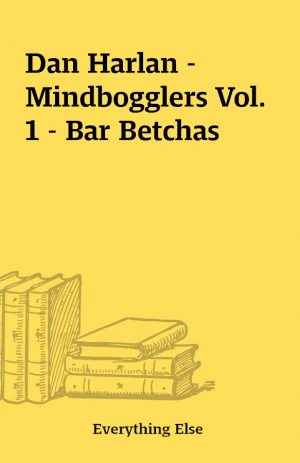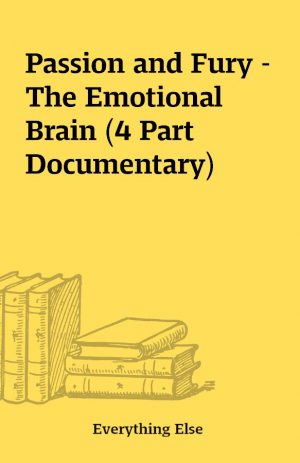Barry Bernstein – Spirals – Healing music
Barry Bernstein – Spirals
[1CD – 3FLAC]
Description
*** ripped from original CD of own collection ***Spirals: Unwinding For Vitality And HealthBarry Bernstein MT-BCLiner notes from the CD “Spirals: Unwinding For Vitality And Health” composed by Barry Bernstein et al., produced by Randy Crafton.Liner notes written by Barry Bernstein, MT-BC, and Lee Veal, DC.Published by The Relaxation Company.TRACK NOTES1. PULSEThe cranial rhythm awakens in the dawn of life and is the last to fall silent in death. As the heart forms and blood is created the heart rhythm overlays the “tidal” cranial rhythm. Emerging from a world of water the newborn takes its first breath of air and another rhythm, the respiratory, overlays the previous two. It is this three-layered rhythm of head, heart, and breath, produced by the three pumps of the body, that maintains the complexity we call life.Each rhythm corresponds to a different layer of tissue and a different layer of consciousness, so entraining with a given rhythm gives access to that layer. The respiratory rhythm resonates with the conscious layer and the gaseous tissue suspended throughout the entire body. The cardiac rhythm connects with the subconscious and the fluid level of tissue. And the cranial rhythm contacts the unconscious and the fascial tissue. A conscious entrainment on all three layers integrates and harmonizes all of them.Simply becoming aware of your body’s three great pumps will help you feel balanced.2. FLOWThe body moves to many rhythms. The three pumps of the body pulse in a complex rhythm of differing frequencies. Each of the horizontal diaphragms modulate these rhythms according to their size, shape, state of tension, and fascial torsion. If one diaphragm is tightened or twisted, it doesn’t transfer the rhythm with its maximum capacity. Each of the diaphragms in your body are naturally programmed to release and relax in rhythmic response.In this piece, two frame drums play polyrhythms based on Pythagoras’s study of natural acoustic proportions that are found in the anatomical structures of the human body. Pythagoras believed that by exposing the body to the specific musical intervals that support these natural ratios, one could enhance their health and well being.In this piece, the first frame drum plays a two-beat rhythm while the second frame drum plays a three-beat rhythm over it (a 2:3 ratio). This creates the interval of a fifth. An interval is the relationship between two tones.The drums have been tuned to create the interval for each rhythm ratio. Other ratios used include 1:2, 3:4, 3:5, 4:5 and 5:8. The diaphragms within the body entrain on these natural rhythmic ratios. As the do, fascialrestrictions and muscular tension are released and the diaphragms begin to resonate freely.3. MOVETo conclude your experience, it is important to move. This track is designed to encourage your body to manifest the spiral in motion.Begin to explore spiral movements with your hands and fingers, with your hips and shoulders, with your head and neck and finally with your feet. Your entire body naturally moves in spiral motions. When we work with our spirals, the body releases into a deep balance, regains its natural resilience and builds a powerful immune system.BARRY BERNSTEIN, MT-BCBarry Bernstein is one of the leaders in the drumming/wellness movement and the founder of the Unity With A Beat! Workshops. He has developed programs and presented papers on the benefits of music therapy for people with mental and physical disorders. With 20 years experience as a Registered Music Therapist, workshop facilitator, and recording artist, Barry advises schools, businesses, and healthcare facilities via his consulting company, Healthy Sounds. The workshops include the training of music therapists, music educators, psychologists, social workers, and nurses in the theory and practice of using rhythm and drumming to promote wellness. He also conducts experiential programs throughout the country for corporate groups, at-risk youth, recovering substance abusers, and well older adults. He co-founded Rhythm For Life, with Grateful Dead drummer, Mickey Hart, and served as its program director for five years.Introduction: Vibratory HealingIn May of 1997 I began working with chiropractor Lee Veal in Kansas City. Our mutual interests in community, healing, and ritual led us to develop therapies using sound and vibration in combination with body work. The impressive results we’ve seen in our patients have encouraged me to share some of the musical and vibrationalcreations that we’ve developed in the course of our collaboration.In many ways this collection [Spirals: Unwinding For Vitality And Health. The Relaxation Company] is a culmination for me, bringing my work as a musician and music therapist together with other interests – including medical anthropology and world healing traditions that use sound.I’ve had many opportunities to see the healing effects of sound at first hand. I was once involved in a team that did extensive research on the effects of rhythm on Alzheimer’s patients. Again and again, we saw patients who were not communicating with the outside world “come alive” when they played and listened to percussioninstruments. These successes led me to try a rhythm-based program with many other types of clients, including Vietnam vets, psychiatric patients, and recovering substance abusers. Rhythm-based music therapy was an overwhelming success every time.I soon began working with the general public in schools, businesses and conference settings. Connecting with Dr. Veal has enabled me to take this work to otherwise healthy people who hold stress in their bodies – the natural (or unnatural) result of living in our fast paced society.The recording Spirals is for everyone to use in the comfort of home, out in nature or at a group retreat. I particularly encourage using Spirals in a group setting; drumming and dancing together are powerful experiences in their own right, and powerful tools for connecting a community, creating both a sonic and a muscular bond among all who take part.The Body’s Spiral RhythmsJust as we need community and synchronicity with our surroundings, so does the tissue in our body. In a sense, the cells of our bodies sing and dance together, following very precise forms and rhythms. One vital form/rhythm, which expresses itself everywhere in our bodies, is the spiral.All life is formed in water, and water naturally flows in spirals. The meanderings of a stream, the curving vortexes of eddies, waves moving toward the shore – they all describe spiral motions, and the spiral is imprinted in all of life. Every part of our body, all of our tissue, carries the stamp of the spiral nature of our birth.Particularly important is the spiral movement that is transmitted throughout our bodies through the fascia, the web of connective tissue that surrounds every organ, every muscle, every vessel in the body. The fascia gives shape to and protects each organ. It surrounds the muscles – and each fiber within the muscles. Fluid movesthrough the fascia in spirals. All the organs held in the fascia rhythmically pulsate in spiral or vortex patterns.The fascia connects the entire body, from the top of the head to the tip of the toes, in a seamless web of spiral movement.When the fascia is traumatized, it tends to solidify and lose its capacity to move. Anything that facilitates the softening of the fascia promotes healing by helping fluid flow throughout the body and allowing the organs to pulsate without impediment. Nutrients can be delivered, waste products can be released, spirit can inhabit thebody’s sacred space.Head Notes: The Cranial RhythmAt the “head” of this great system of fascial pulsing is the cranial rhythm, the slow and steady pulse of the brain. The notochord, the primitive nervous system of an embryo, is the body’s first rhythm instrument – it begins pulsing even before the heart and lungs are formed. As the notochord grows and develops, folding and bulging, that pulsation actually becomes a coiling and uncoiling. Gradually, as each new layer of the brain is formed, that coiling and uncoiling continues. When the dura mater, the part of the fascia that surrounds the brain and spinal cord, is resistant, inhibiting the movement of the brain, the brain cells are not nurtured or cleansed, their function is diminished, and a toxic state develops. With the return of the dura mater to its normalspiral motion, the brain can be cleared of toxins and the metabolism of the brain and nerve cells improve.The cranial rhythm pulses at about 6 to 11 beats per minute. This rhythm is propagated by the fascia, and since the fascia is one continuous sheet between nose and toes, the brain pulse can be felt throughout the entire body.In fact, it joins an intricate, oceanic pattern of bodily rhythm. The heart, which pulses at 60 – 80 beats per minute, can be compared to the breaking waves of the ocean. The respiratory rhythm is 12 – 18 beats per minute and resembles the swells under the waves. The cranial rhythm is the slower, tidal rhythm that underlies it all.Matching the cranial rhythm with healing external sound helps the fascia soften and release and enhances the immune system by allowing greater flow throughout the entire body.Horizontal Bop: The Fascial Diaphragms The body is an intricate interplay of many fascial systems. One fascial system runs vertically, head to toe, and includes arteries and veins, nerves and lymphatic vessels. The subtle energies of Indian Tantrism and Chinese Taoism – kundalini and qi – also flow along this axis. Other fascial systems have a horizontal orientation, dividing the vertical organism into compartments. Within each of these, a diaphragm or diaphragm-like structure operates, vibrating in response to many influences. There are seven such fascial diaphragms: the ankles, the knees, the perineum, the pelvic floor, the respiratory diaphragm, the thoracic outlet (shoulder girdle), and the tentorum between the cerebellum and cerebrum in the brain. Each diaphragm controls the passage of a particular array of fluids, and electrical and subtle energies, including qi and kundalini. If the resonance of the fascial diaphragm is restricted the fluid flow is also restricted. As in the rest of the fascial system, release of restrictions enhances the flow and exchange of fluid, energy, and movement.Making Waves: Sound And The Fascial SystemThe fascial system tends to resonate or entrain with the vibrations that surround it. Different musical instruments have different effects depending on the shape of the sound waves their tones create. A vibrating membrane, a plucked string, a struck bell, or a tube of air – they each affect the body differently. (People who live around constant traffic noise have a different fascial “feel” from those who live around gentle natural sounds.) For example, when a didgeridoo player blows his instrument, his lips excite the air and create a spiraling vortex. When the body’s diaphragms begin to resonate with, and entrain on, this spiraling vortex wave form, the entire system relaxes an the fascial system softens, opening the passageways. The diaphragms resonate and relax, encouraging a free and healthy flow of qi.
You must be logged in to post a review.






Reviews
There are no reviews yet.